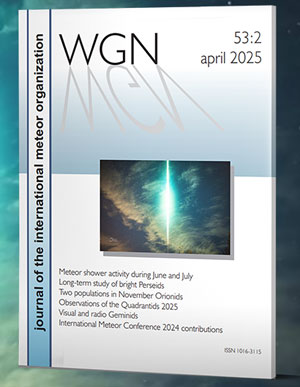This weekend and for the remainder of this period, the moon will be present in
the sky most of the night, limiting the meteor activity to be seen. The sources
of meteors listed below are active during this period but will be difficult to
observe. If your sky is transparent and the limiting magnitude exceeds +5.0,
then you may be able to achieve some success at observing during this period.
The estimated total hourly rates for evening observers this week is near two
for those in the Northern Hemisphere and three for those located in the
Southern Hemisphere. For morning observers the estimated total hourly rates
should be near six for those located in the Northern Hemisphere and twelve for
those in the Southern Hemisphere. These rates assume that you are watching from
rural areas away from all sources of light pollution. The actual rates will
also depend on factors such as personal light and motion perception, local
weather conditions, alertness and experience in watching meteor activity. Rates
are reduced this week due to intense moonlight.
The full listing will continue next week when the moon reaches its last quarter phase and is not such a nuisance to observers.
[CSV]
Shower, Maximum, Celestial Postition
RA (RA in Deg.) DEC, Entry Velocity
Km/Sec, Culmination
Local Standard Time, Hourly Rate
North-South, Class*
Delta Velids (DVE), Feb 14, 08:40 (130) -51, 35, 0:00, >1 – >1, IV
Eclipticids (ECL), Mar 24, 11:08 (167) +09, 28, 2:00, 2 – 1, II
Omicron Centaurids (OCE), Feb 14, 11:40 (175) -55, 51, 3:00, >1 – 1, IV
Theta Centaurids (TCE), Feb 14, 13:52 (208) -40, 60, 4:00, >1 – 1, IV
Alpha Centaurids (ACE), Feb 8, 14:24 (216) -60, 56, 5:00, >1 – 4, II
[/CSV]
detailed explanation on the different classes of meteor showers and other astronomical terms.




 You saw something bright and fast? Like a huge shooting star? Report it: it may be a fireball.
You saw something bright and fast? Like a huge shooting star? Report it: it may be a fireball.  You counted meteors last night? Share your results with us!
You counted meteors last night? Share your results with us!  You took a photo of a meteor or fireball? You have a screenshot of your cam? Share it with us!
You took a photo of a meteor or fireball? You have a screenshot of your cam? Share it with us!  You caught a meteor or fireball on video? Share your video with us!
You caught a meteor or fireball on video? Share your video with us!